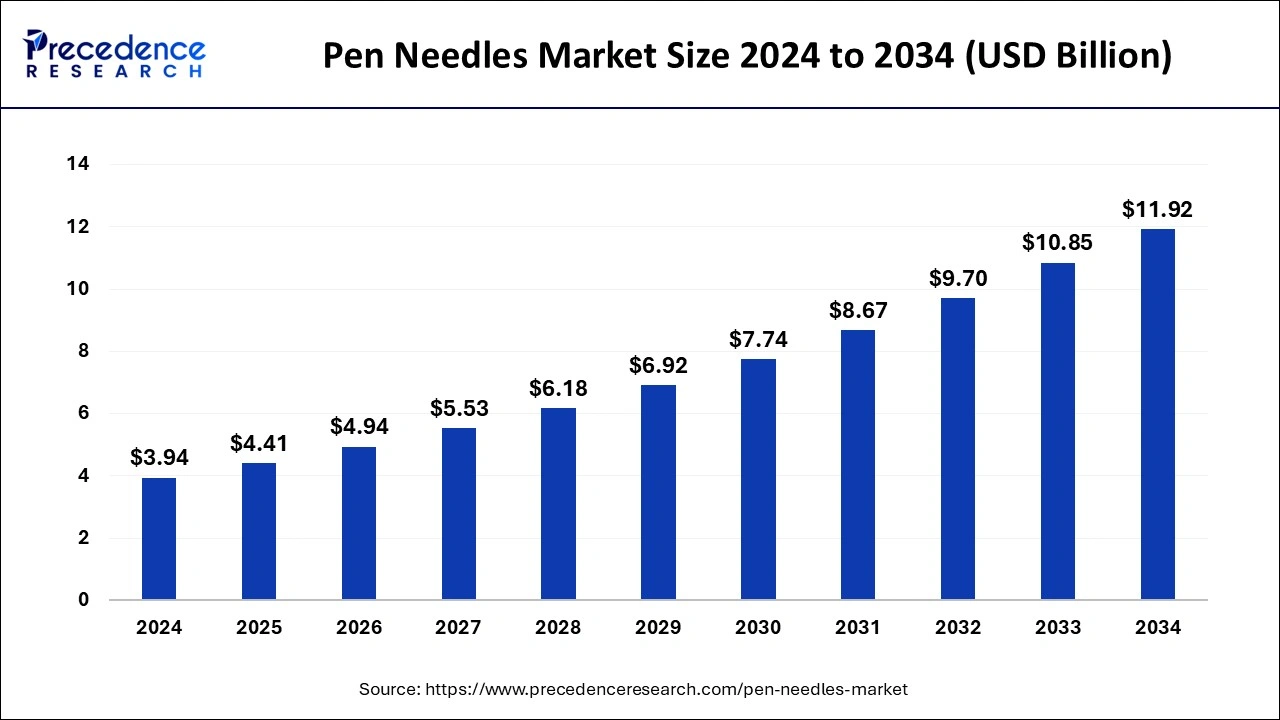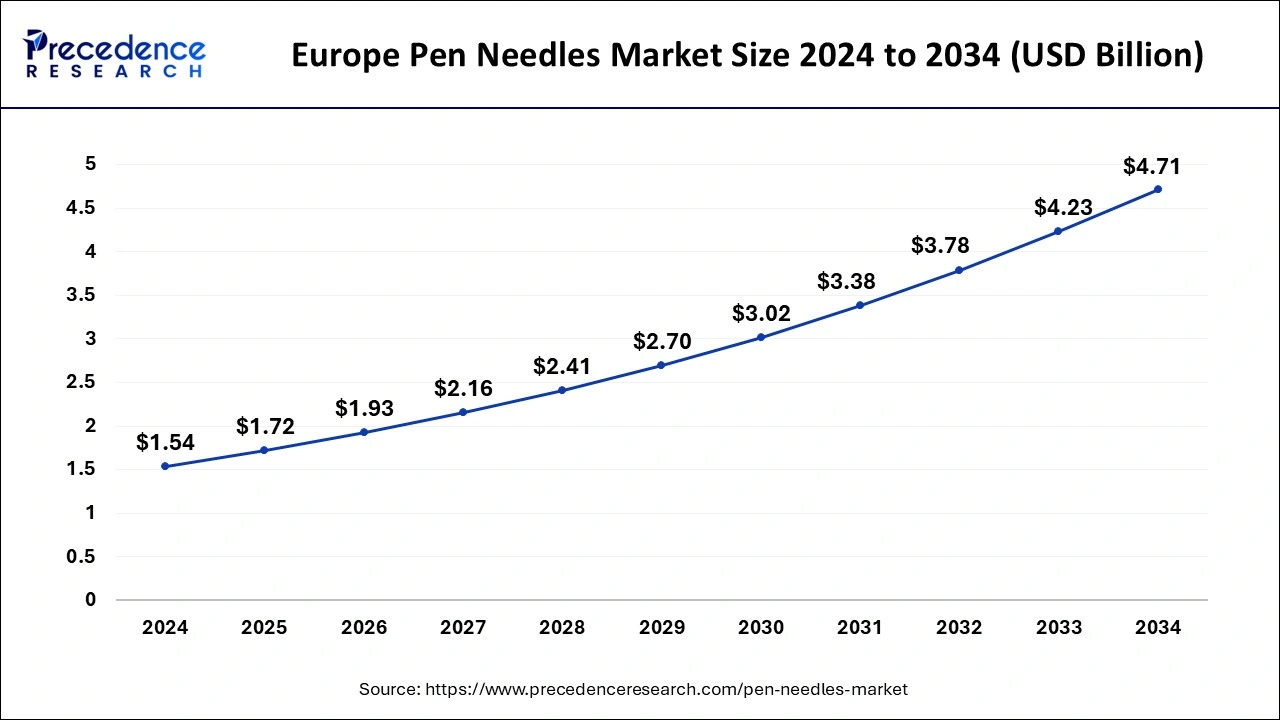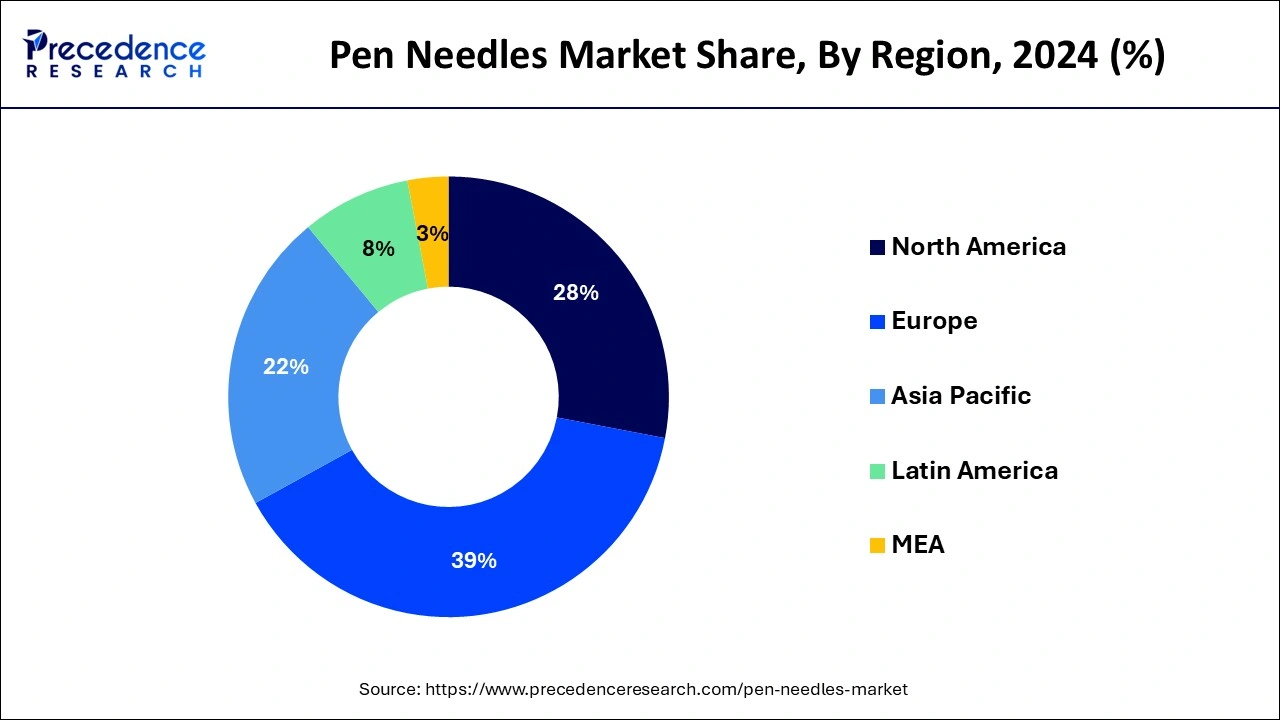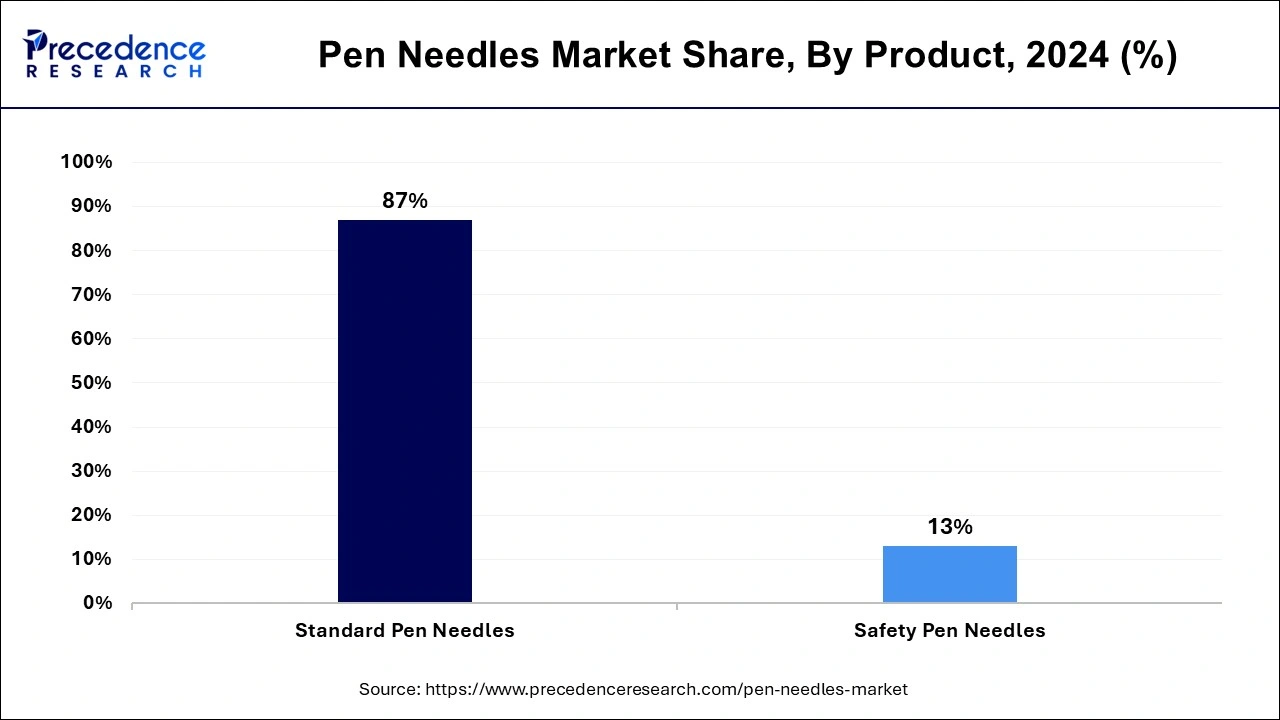July 2024
The global pen needles market size is calculated at USD 4.41 billion in 2025 and is forecasted to reach around USD 11.92 billion by 2034, accelerating at a CAGR of 11.71% from 2025 to 2034. The Europe market size surpassed USD 1.54 billion in 2024 and is expanding at a CAGR of 11.83% during the forecast period. The market sizing and forecasts are revenue-based (USD Million/Billion), with 2024 as the base year.
The global pen needles market size accounted for USD 3.94 billion in 2024 and is predicted to increase from USD 4.41 billion in 2025 to approximately USD 11.92 billion by 2034, expanding at a CAGR of 11.71% from 2025 to 2034.

The Europe pen needles market size was evaluated at USD 1.54 billion in 2024 and is projected to be worth around USD 4.71 billion by 2034, growing at a CAGR of 11.83% from 2025 to 2034.

Europe has held the largest revenue share of 39% in 2024. Europe holds a major share in the pen needles market due to several factors. The region has a high prevalence of diabetes, driving the demand for efficient insulin delivery methods. Additionally, robust healthcare infrastructure, stringent regulatory standards, and a well-informed patient population contribute to the widespread adoption of pen needles. The presence of key market players and a proactive approach toward technological advancements in diabetes management further solidify Europe's prominent position in the global pen needles market.
Asia-Pacific is estimated to witness the highest growth. The region benefits from a high prevalence of diabetes, developing healthcare infrastructure, and a significant diabetic patient population. Favorable reimbursement policies, widespread awareness about advanced diabetes management tools, and early adoption of innovative medical technologies contribute to the market's substantial share. Additionally, ongoing research and development activities and strategic collaborations among key market players in Asia Pacific further solidify the region's leading position in the global pen needles market.

Pen needles are small, disposable devices used in conjunction with insulin pens for the administration of insulin in diabetic patients. These needles play a crucial role in simplifying the process of insulin injection, providing a convenient and efficient method for individuals managing diabetes. Typically featuring a fine, short, and thin design, pen needles are designed to minimize pain and discomfort during injection while ensuring accurate and consistent dosage delivery.
The usage of pen needles has become a standard practice in diabetes management, offering patients a discreet and user-friendly way to self-administer insulin. With varying needle lengths and gauges, individuals can choose a needle size that suits their comfort and injection preferences. The innovation of pen needles has significantly improved the quality of life for diabetic patients, promoting better adherence to treatment regimens and enhancing overall diabetes care.
| Report Coverage | Details |
| Growth Rate from 2025 to 2034 | CAGR of 11.71% |
| Market Size in 2025 | USD 4.41 Billion |
| Market Size in 2024 | USD 3.94 Billion |
| Market Size by 2034 | USD 11.92 Billion |
| Largest Market | Europe |
| Base Year | 2024 |
| Forecast Period | 2025 to 2034 |
| Segments Covered | Product, Needle Length, Therapy |
| Regions Covered | North America, Europe, Asia-Pacific, Latin America, and Middle East & Africa |
Rising diabetes prevalence and patient preference for self-administration
The increasing worldwide occurrence of diabetes is a primary driver propelling the demand for pen needles. As more people grapple with diabetes, the need for practical and user-friendly insulin delivery methods intensifies. Pen needles emerge as a solution that is not only efficient but also empowers patients to administer insulin independently. The rise in diabetes prevalence directly correlates with a heightened demand for pen needles, establishing them as a crucial tool in managing the condition.
Furthermore, there is a noticeable uptick in patients preferring self-administration. Contemporary healthcare principles emphasize patient involvement in their treatment, and pen needles align seamlessly with this philosophy. By allowing individuals to take charge of their insulin therapy, pen needles enhance patient satisfaction and contribute significantly to the growing market demand for a preferred and self-administered insulin delivery system.
Cost concerns and needlestick injuries
Cost concerns and needlestick injuries act as significant restraints on the pen needles market. The expense associated with pen needles can be a substantial barrier, limiting accessibility for individuals with financial constraints or those residing in regions with inadequate healthcare coverage. This financial hurdle may deter potential users from adopting pen needles as their preferred insulin delivery method, hindering market growth. Additionally, despite advancements in safety features, concerns about needlestick injuries during disposal persist.
Healthcare professionals and patients alike worry about accidental needle pricks, which may lead to hesitancy in embracing pen needles. The perceived risk of injury could contribute to reluctance among both healthcare providers and individuals with diabetes, impacting the widespread acceptance and adoption of pen needles in the market. Addressing these concerns through cost-effective solutions and further enhancing safety features is crucial to overcoming these restraints and promoting the broader use of pen needles in diabetes management.
Patient education programs and sustainability initiatives
Patient education programs represent a significant opportunity in the pen needles market by empowering individuals with diabetes. As awareness about the condition grows, educating patients on the benefits and proper usage of pen needles becomes crucial. Comprehensive programs that provide information on self-administration techniques, safety features, and the advantages of using pen needles can enhance acceptance and foster market expansion. Informed patients are more likely to opt for these devices, driving demand and contributing to the overall growth of the market.
Sustainability initiatives are creating opportunities by addressing environmental concerns associated with pen needle disposal. As the world focuses on eco-friendly practices, manufacturers exploring sustainable materials and disposal options for pen needles can gain a competitive edge. Environmentally conscious consumers are more likely to choose products with minimal ecological impact, presenting an avenue for market differentiation. Embracing sustainability not only meets consumer expectations but also aligns with global trends, positioning pen needle manufacturers to tap into a growing market segment concerned about both personal health and environmental impact.
In 2024, the standard pen needle segment held the highest market share of 87% on the basis of the product. In the pen needles market, the standard segment refers to conventional pen needles widely used for insulin delivery. These needles typically have a fixed length and gauge, providing a standardized approach to insulin administration. Trends in the standard segment include ongoing efforts to enhance needle technology for improved patient comfort, safety features to minimize needlestick injuries, and advancements in manufacturing processes to ensure cost-effectiveness. Despite the growth of specialty pen needles, the standard segment continues to dominate, meeting the needs of a broad patient population seeking reliable and straightforward insulin delivery solutions.

The safety pen needles segment is anticipated to witness the highest growth with a significant CAGR of 13.1% during the projected period. The safety pen needles segment in the pen needles market refers to devices designed with enhanced safety features to minimize the risk of needlestick injuries. These needles often incorporate mechanisms such as retractable or shielded needles, providing an added layer of protection for healthcare professionals and patients during and after use.
A prevailing trend in the safety pen needles segment involves continuous innovation in safety technologies, including automatic needle retraction systems and user-friendly designs. These advancements aim to further reduce the occurrence of needlestick injuries and enhance the overall safety profile of insulin delivery devices.
According to the needle length, the 8mm segment has held a 35% revenue share in 2024. The 8mm segment in the pen needles market refers to a specific needle length commonly used in insulin pens for subcutaneous injections. This segment is popular due to its versatility, suitable for a broad range of patient populations. Trends indicate a growing preference for shorter needle lengths, like 8mm, as they offer a balance between effective insulin delivery and reduced discomfort. This trend aligns with the industry's focus on enhancing patient experience, emphasizing painless and convenient injection methods for improved adherence to insulin therapy.
The 4mm segment is anticipated to witness the highest growth over the projected period. The 4mm segment in the pen needles market refers to needles with a length of 4 millimeters. This segment is characterized by its suitability for individuals with varying body types, offering a shorter and less intrusive option for insulin injection. A prominent trend in this segment is the increasing preference for shorter needle lengths, driven by the emphasis on patient comfort and the recognition that shorter needles can reduce the fear and discomfort associated with injections. The 4mm segment reflects a user-centric approach, aligning with the evolving needs and preferences of individuals managing diabetes.
According to the therapy, the insulin segment has held a 78% revenue share in 2023. The insulin segment in the pen needles market refers to devices specifically designed for the administration of insulin, a vital hormone for diabetes management. As a key trend, there is a continual shift toward the development of pen needles with advanced features, such as ultra-thin needles and painless injection options, enhancing patient comfort. Additionally, customization options in needle lengths and gauges within the insulin segment cater to the diverse needs of patients, contributing to the overall trend of personalized and patient-centric insulin therapy.
The glucagon-like-peptide-1 segment is anticipated to witness the highest growth over the projected period. In the realm of pen needles, the GLP-1 segment pertains to devices tailored for the delivery of GLP-1 receptor agonists, commonly prescribed for type 2 diabetes treatment. A noteworthy trend within this sector is the growing favorability towards GLP-1 receptor agonists, attributed to their effectiveness in blood glucose control and potential weight management benefits. With an increasing number of patients choosing GLP-1-based therapies, the demand for dedicated pen needles compatible with these medications is on the ascent, signifying a notable uptrend in this specific segment of the market.
By Product
By Needle Length
By Therapy
By Geography
For inquiries regarding discounts, bulk purchases, or customization requests, please contact us at sales@precedenceresearch.com
No cookie-cutter, only authentic analysis – take the 1st step to become a Precedence Research client
July 2024
August 2022